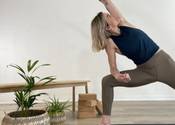From Good to Great: How Yoga Can Transform Your Running

Contents
As a runner, you’re likely always looking for ways to improve your performance and avoid injury.
While strength training, stretching, and proper nutrition are all essential elements of any training programme, yoga has gained popularity as a powerful tool that can enhance your running experience.
In this article, I will explore the various benefits of incorporating yoga into your running routine, and how it can help you achieve greater physical and mental well-being, both on and off the road.
Enhanced Range of Motion
When you run, your body moves through a wide range of motions: from the extension of your legs during the push-off phase to the contraction of your core muscles as you maintain a stable posture. Tightness and imbalance in your body can limit this range of motion, impeding your ability to maintain a proper stride and putting extra stress on certain parts of your body, such as your hips, knees, and ankles.
Yoga, with its emphasis on full-body movements and deep stretching, can help to loosen up those tight muscles and increase your overall flexibility. By working on your flexibility and balance through yoga, you can help to correct these imbalances and increase your range of motion. This, in turn, can lead to improvements in your running form, allowing you to move more efficiently and effectively.
When your body is more flexible, you’ll be less likely to experience overuse injuries, such as runner’s knee or shin splints, which are often caused by repetitive stress on certain parts of the body. Additionally, increased flexibility can help prevent muscle strains and tears that can occur when your muscles are tight and inflexible.
Improved Core Strength and Stability
As a runner, maintaining proper running form and avoiding injuries are key factors in your success. A strong core is crucial in achieving both. A strong core not only provides stability for your lower back but also helps to transfer power from your legs to your upper body, enabling you to run more efficiently and with less effort.
Most forms of yoga teach you to engage and strengthen the muscles in your abdomen, back, and hips, providing you with a stable foundation for your running practice. Yoga postures like plank, boat, and downward-facing dog can target your core muscles, including your rectus abdominis, transverse abdominis, obliques, erector spinae, and glutes.
By incorporating yoga into your running routine, you’ll not only strengthen your core muscles but also improve your posture and alignment. This, in turn, can help reduce the strain on your lower back, hips, and knees, which are common areas of injury for runners. A strong core also helps to prevent excessive rotation of your torso while running, which can lead to a less efficient stride and wasted energy.
A strong core also allows you to maintain proper posture and balance while running, which can lead to improvements in your overall performance. When your core muscles are strong, you’ll be able to run more efficiently and with less effort, allowing you to go further and faster with greater ease.
Better Balance and Coordination
Yoga is well-known for its ability to improve balance and coordination.
Many yoga poses require you to balance on one foot, engage multiple muscle groups simultaneously, or hold a posture for an extended period of time. These poses can help improve your proprioception, which is your body’s ability to sense and respond to its position in space. By improving your proprioception, you’ll be able to make more precise movements, react more quickly to changes in terrain, and maintain a steady stride.
Practicing yoga can also help improve your neuromuscular coordination, which is your body’s ability to coordinate the actions of your muscles in a precise and efficient manner. Multiple muscle groups are engaged at once, helping to improve your body’s ability to work together as a unit. This, in turn, can help you avoid injuries caused by missteps, as your body will be better equipped to respond to sudden changes in direction or terrain.
This focus on balance and coordination translates directly to running by helping you navigate uneven terrain, maintain a steady stride, and avoid injuries caused by missteps.
Reduced Stress and Mental Clarity
Running is often seen as a form of meditation, and the addition of yoga to your routine can further enhance this aspect.
The deep breathing and mindfulness techniques used in yoga can help manage stress and anxiety, both of which can negatively impact your running performance. It helps with focusing on your breath and staying present in the moment, allowing you to let go of distracting thoughts and worries.
Yoga has been found to reduce the levels of cortisol – a stress hormone – in your body. High levels of cortisol can lead to increased feelings of anxiety and tension, making it harder for you to relax and enjoy your running practice. By reducing cortisol levels, you’ll be able to enter a more relaxed and calm state of mind, improving your ability to focus and perform.
The deep breathing and mindfulness techniques used in yoga help reduce stress and increase mental clarity. This improved mental state can lead to better focus, allowing you to push through tough runs and reach your goals.
Faster Recovery and Reduced Muscle Soreness
Running can be tough on your muscles, and it’s not uncommon to experience soreness and stiffness after a long run.
Yoga can help improve blood flow to your muscles, which in turn helps deliver oxygen and nutrients to your muscles, promoting faster recovery. Gentle forms of yoga, such as yin or restorative yoga, can help mobilise and gently stretch your muscles, promoting blood flow and aiding in the recovery process.
It can help reduce muscle soreness by releasing tension and promoting relaxation in the muscles. Certain yoga poses, such as pigeon pose or reclined butterfly pose, can help target specific areas of tightness and tension in your muscles, helping to alleviate soreness and prevent injury.
Incorporating yoga into your post-run routine can help alleviate tightness, prevent injury, and get you back on the road faster.
Body Awareness and Injury Prevention
Yoga encourages body awareness by asking you to pay attention to how your body feels and moves in each pose. This heightened awareness can help you notice any imbalances or discomfort in your running form, allowing you to make adjustments and prevent injury.
The important key to getting these different benefits is finding the right type of class, and the right teacher. Seeking out specialist classes aimed at runners, sports or mobility and strength will help with the strength, stability, coordination and range of motion; whereas to get the recovery, reduced stress and good practice with mental clarity classes such as restorative yoga, Yin yoga or gentle Hatha are best suited.
Yoga and running make the perfect partnership, providing you with a well-rounded fitness routine that enhances both your physical and mental well-being. Whether you’re a casual jogger or an experienced marathoner, incorporating yoga into your routine can help you unlock your full potential as a runner.
So, roll out that yoga mat, and let’s get started on the path to a more flexible, stronger, and happier you. Namaste, fellow runners!
To find out about Helena’s classes, designed for Sports and Healthy Movement go to origamia.co.uk or follow her on instagram instagram.com/iamhelenabyles/







